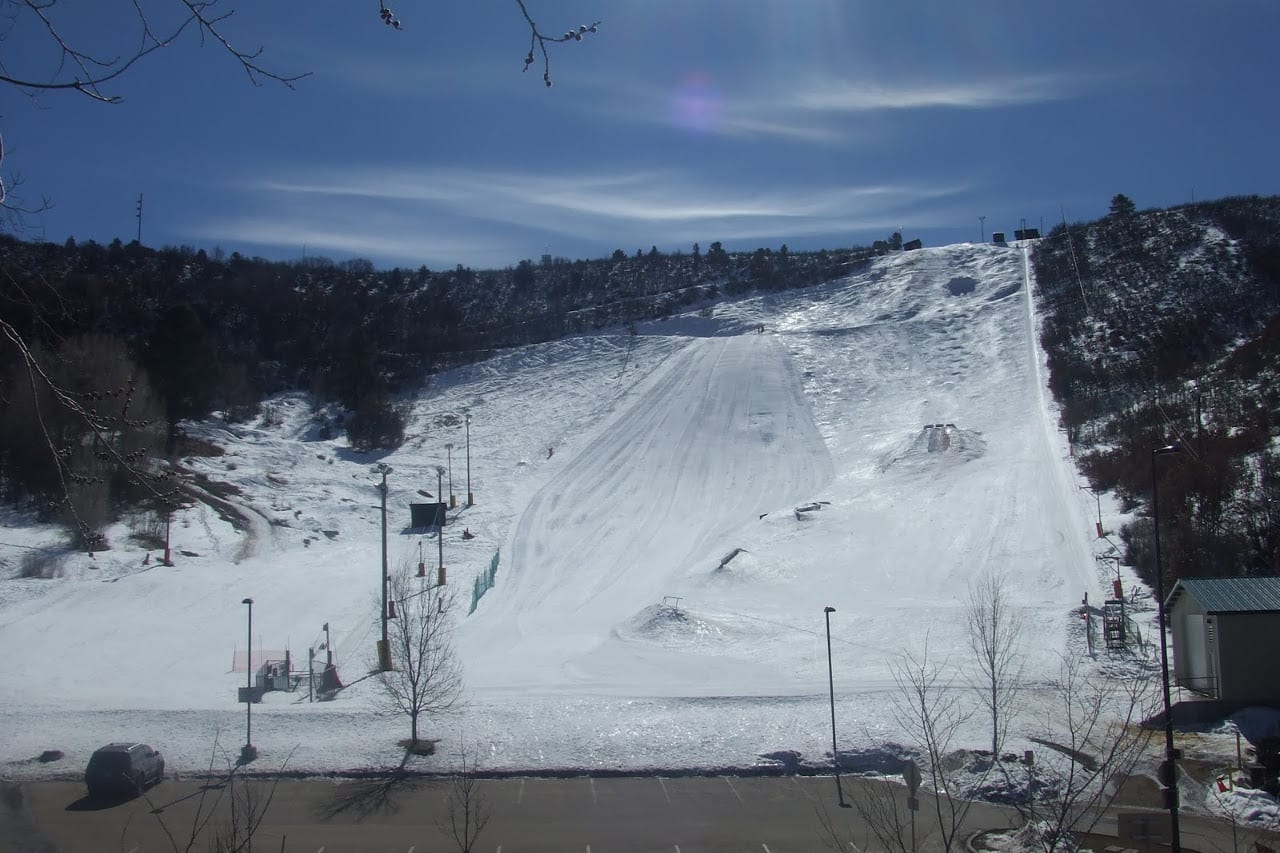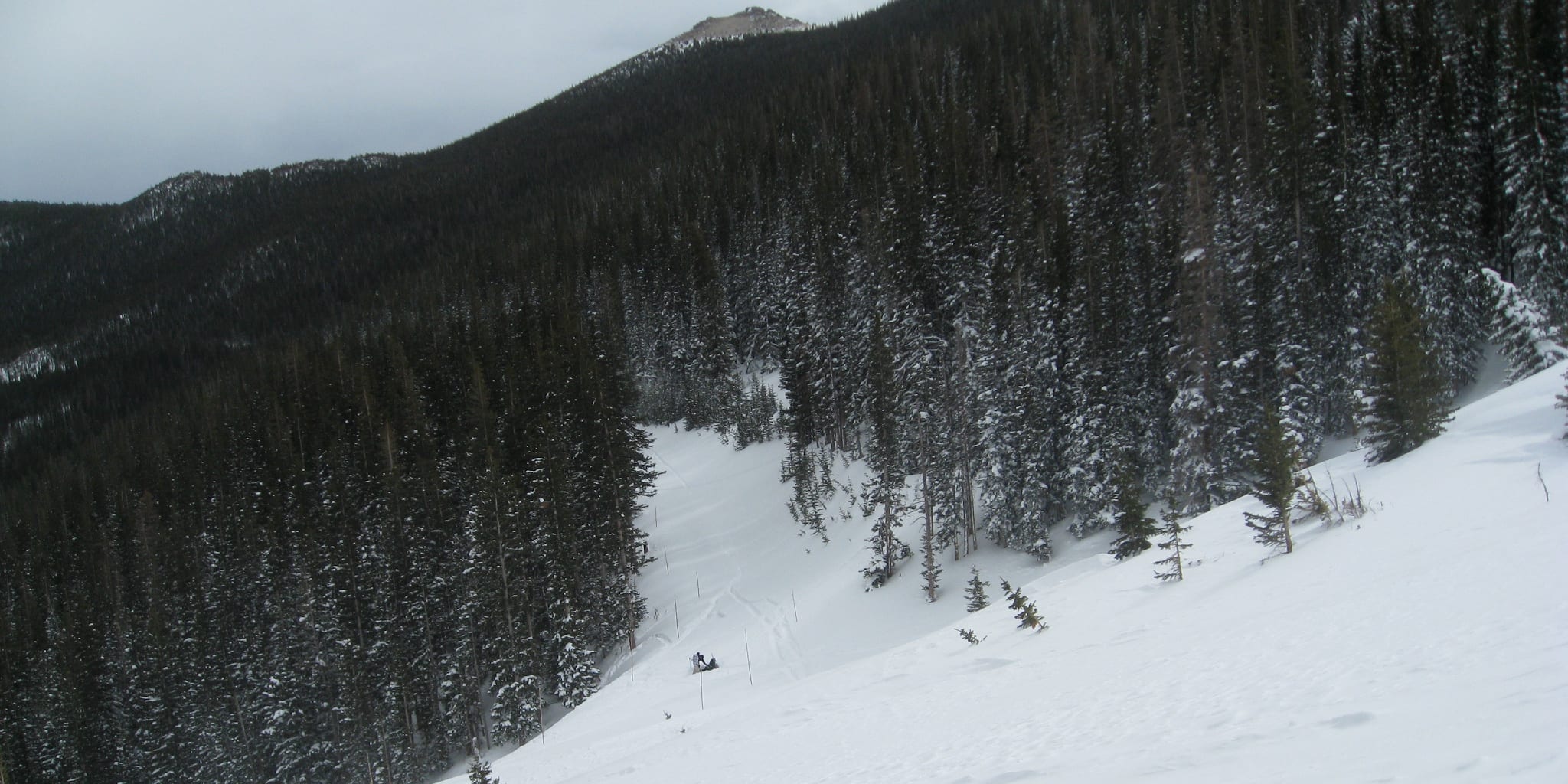Some of the most fascinating remnants of Colorado’s ski history are its lost and abandoned ski resorts. They’re often sighted by the scars that the old runs have left upon the mountains.
Of around 150 resorts that have been operated in this state, only around thirty remain open today. Despite this, the internet preserves images and stories of these ghost ski areas, some chronicling the adventures of backcountry skiers who’ve decided to tackle the old, ungroomed trails.
They keep alive the memory of these lost resorts. Today, we’ll explore the rise and fall of seven of Colorado’s former ski areas, some of which locals are still hopeful will eventually reopen.
Here are seven of the hundred-plus abandoned ski resorts in Colorado, in no particular order:
Ski Broadmoor, Colorado Springs
Ski Broadmoor was the largest and the longest-operating ski area in Colorado Springs. It was opened as part of the Broadmoor Resort in 1959, with one double chair lift, one tow line, and state-of-the-art snowmaking machines. Ski Broadmoor was known as one of the most popular ski areas on the Front Range and was home to some of the best American skiers of the ’60s and ’70s.
In 1986, The Broadmoor sold the ski area to the city of Colorado Springs. The city was unprepared to take on such a big responsibility, especially when faced with expensive infrastructure repairs that were required to keep the area up to date. Unwilling to raise ticket prices, the city took the bill for the repairs, then sighed in relief when an offer came in from Vail to buy the ski area in 1991.
Unfortunately, once ownership passed hands to the Vail Resort, the ski area was promptly shut down to eliminate competition with other resorts along the I-70 corridor. Many cite the lack of snowfall in Colorado Springs as another reason for the area’s eventual closing. The scar of Ski Broadmoor is still visible from some areas of Colorado Springs, a mark of the lost legacy of the ski area in the shadow of Pikes Peak.
Berthoud Pass Ski Area, south of Winter Park
Berthoud Pass had a long history of firsts before its eventual closing. It opened as Colorado’s first official ski area in 1937 due to the labor of volunteers to create Colorado’s very first rope tow.
In 1947, the resort added the first double-seat chairlift in the state as well and broke boundaries in the 1970s by allowing snowboarders on chairlifts (along with hosting what may have been the state’s first snowboarding competition).
However, due to many safety issues, permitting issues, the rising competition and popularity of the Winter Park Mountain Resort, plus many owner changes throughout the years, Berthoud Pass closed its chair lifts for good in the late 90s and began operating as an expert-only area for the last few years of its life. In 2003, Berthoud Pass was closed for the last time, and two years later the Forest Service destroyed the lodge that stood at its base.
Berthoud Pass Ski Area might be officially gone for now, but it will always remain a huge part of Colorado’s skiing and boarding history. Today, it remains a destination for backcountry skiers and boarders who want to keep the legacy of this ski area alive. Drive over the pass during the winter and you’ll see skiers gearing up, and hitchhikers looking for a ride from the bottom.
Geneva Basin Ski Area, Guanella Pass
Geneva Basin Ski Area was originally opened as Indianhead Ski Area in 1963. At the time, the park boasted two chair lifts, which allowed skiers to ascend to the top of Guanella Pass. Two more were added a few years later to give access to beginner hills and bowls that dot the area.
One of the main reasons for the Geneva Basin’s eventual downfall was the financial problems that plagued the ski area every step of the way. In 1984, this was made worse by an accident with one of the chair lifts that forced the resort to shut down until the problem could be resolved.
Many different owners attempted to complete the repairs necessary, but the Geneva Basin never reopened. In 1993, the lodge was burned down by the Forest Service to prevent anyone from trying to open it again, but the former ski patrol base remains visible today. Today the abandoned trails of the former ski resort remain a destination for backcountry skiers looking to get away from the crowds and the chair lifts of the big resorts.
Cuchara Mountain Resort, Cuchara
Cuchara Mountain Resort opened in 1981 as Panadera Ski Area and operated for eight years under its original owners. However, the resort ran into financial trouble when the owners decided to add two new chairlifts, forcing the park to remain closed between 1989 and 1992.
Ownership changed many times in the period that followed until one businessman decided to reinvigorate the resort with a new life. This, along with a great opening year for snow, helped to keep the property open between 1997 and 2000.
In 2000, the park was closed for good. A year later, the Forest Service pulled the area’s permit, leaving it defunct for almost two decades. In 2017, the land in the village of Cuchara was purchased by Huerfano County using funds raised by the Cuchara Foundation.
Although Cuchara Mountain Park, the area’s new name, no longer operates as a ski area, there are still opportunities to explore over 50 acres of backcountry trails today. Volunteers donated their time and energy to turn the original resort’s base into a day lodge that can be rented out for many different activities. Cuchara Mountain Resort may be a memory, but the park itself is open again due to the tireless work of the volunteers from the Cuchara Foundation.
Idlewild, Winter Park
Downtown Winter Park was not always a part of the city–in the 1960s, the area was known as Hideaway Park and was home to Ski Idlewild, which began operation in 1961. At the time, there were two separate lodges with many different amenities such as tennis courts, swimming pools, and many cross-country skiing trails.
Idlewild was a favorite of novice skiers, especially with the addition of a second chairlift, which gave better access to the park’s northern runs and novice hills. The resort ran into trouble, however, in 1986 after a chairlift malfunctioned. Thankfully, no one was injured, but the chair lifts were forced to close, starting the beginning of the end for Ski Idlewild.
Although there were many attempts to revitalize the property, including the ‘96-’97 summer and winter seasons for which it briefly reopened, Ski Idlewild never regained its lost crowds of skiers.
Today, many of the cross-country trails remain open to backcountry skiers, although the ski area itself is private property. Despite this, the locals remember the ski area fondly, as it was a great place for beginners to start learning, and there is even a road and campground still named after the ski area nearby.
Hidden Valley Ski Area, Estes Park
Hidden Valley Ski Area opened officially in Estes Park in 1955, but the area had been known to skiers since the 30s. Before its official opening, trucks would shuttle skiers to the top of the mountain and pick them up at the base, a system that worked well until two T-bars were installed, with 2 chair lifts being added later on and one double chair lift in operation briefly during the ’70s.
This ski area was known to many to be quite challenging and hilly, with evenly split terrain between beginner, intermediate, and advanced runs. Hidden Valley began to see a drop in visitors in the late ’80s due to competition from other resorts in the area. Although this park closed its doors and sold its lifts in 1991, its hills still remain a popular place for sledding, tubing, and backcountry skiing in RMNP just a few miles away from Estes Park.
Stagecoach Ski Area, south of Steamboat Springs
Ambitiously designed to be one of the largest ski areas in Colorado, Stagecoach Ski Area is known for disastrous funding issues that forced the partially-built resort to close down soon after its grand opening. This ski area operated briefly between 1972 and 1974, never fulfilling its initial designs and promise. It’s still remembered today for its 2,200-foot vertical drop as well as the hopes of the skiing and boarding communities to eventually revitalize the property.
There have been numerous attempts over the last few decades to push the owners of the land towards reopening Stagecoach, but it looks as if there are no current plans to open the ski hill again anytime soon. Though rumors pop up every few years about Stagecoach’s possible reopening, it remains to be seen if this ski area has a future in Colorado. It’s unique in that’s located on private land in Oak Creek, whereas most ski resorts are on leased land by the federal government.
Other Lost Ski Resorts and Small-Town Ski Areas

Once a ski resort is abandoned, it’s usually gone for good, so enjoy Colorado’s ski resorts to the fullest. Some have revivals though, such as Squaw Pass Ski Area, which closed down for decades before reopening as Echo Mountain Park, still open today.
If you’re interested in a more complete list of Colorado’s ghost ski areas, check out Colorado Ski History’s site. They share additional details, as well as personal anecdotes and pictures of these old ski areas. It covers a great majority of the lost ski resorts of the Colorado Rockies.
Want to get your fix on small ski slopes and feel the nostalgia of skiing’s yesteryears? Take a glance at our list of small-town ski areas, all run by the local city or county. Find one that will remind you of the ski hills of your youth. Support these local ski areas before they become lost as well! These are some of the last living links to Colorado’s old ski history.


 Brief Timeline of Colorado’s Ski and Snowboard History
Brief Timeline of Colorado’s Ski and Snowboard History